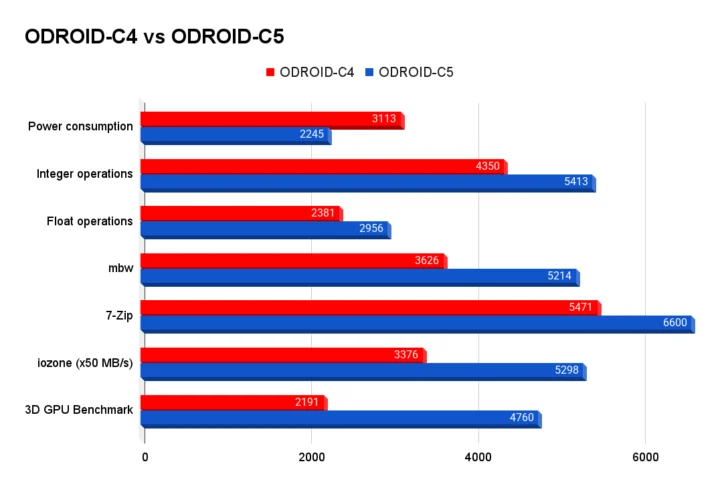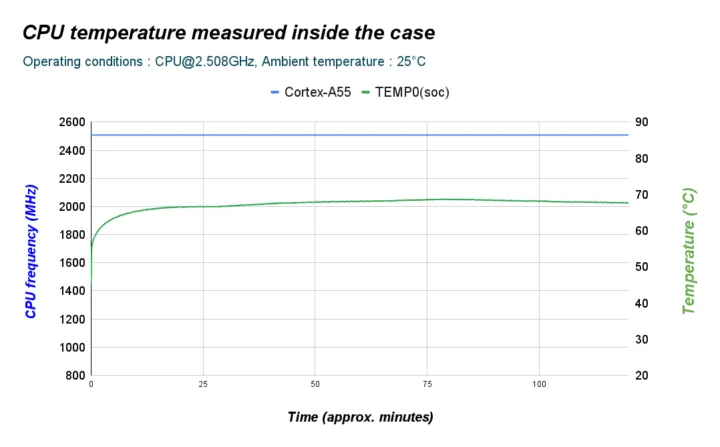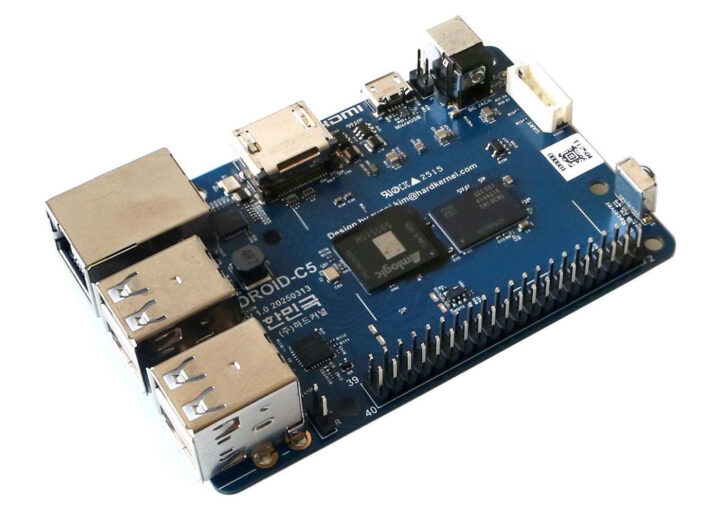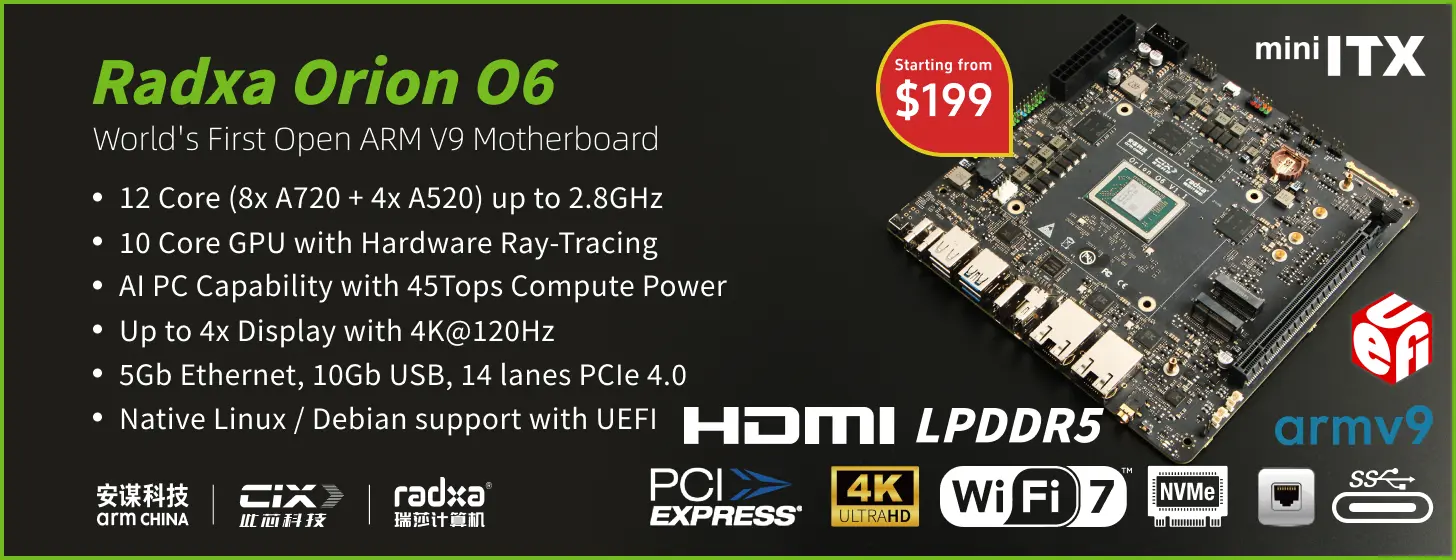Hardkernel ODROID-C5 is a lower-cost upgrade to the ODROID-C4 SBC with a faster and more efficient Amlogic S905X5M quad-core Cortex-A55 SoC clocked at 2.5 GHz, 4GB DDR4 RAM, and almost the same features as the previous generation Amlogic S905X3 single board computer.
That means a microSD card slot and an eMMC flash module socket for storage, HDMI 2.0 video output up to 4Kp60, a Gigabit Ethernet RJ45 port, four USB ports, and the usual 40-pin Raspberry Pi GPIO header.
ODROID-C5 specifications:
- SoC – Amlogic S905X5M
- CPU – Quad-core Cortex-A55 processor @ 2.5 GHz
- GPU – Arm G310-V2 GPU @ 850 MHz supporting OpenGL ES 3.2, Vulkan 1.0 and OpenCL 2.0
- VPU
- Video Decoding – 4Kp75 10-bit: AV1, H.265, VP9, AVS2; 4Kp30: H.264
- Video Encoding – 1080p30 H.264
- System Memory – 4GB DDR4 @ 3200MT/s
- Storage
- eMMC module connector with HS400 speed (16, 32, 64GB, 128GB, and 256GB modules available)
- MicroSD slot with support for DS/HS mode up to UHS-I SDR104
- Video Output – HDMI 2.0 port up to 4K @ 60Hz with HDR, CEC, EDID
- Audio – Analog stereo line out, digital audio via HDMI
- Connectivity
- Gigabit Ethernet RJ45 port
- Optional WiFi with USB dongle
- USB
- 4x USB 2.0 host ports
- micro USB 2.0 OTG port for host or device mode (not for power input)
- Expansion
- 40-pin I/O header with up to 25x GPIO, 6x PWM, 2x ADC (12-bit, 1.8V max), 2x I2C, 1x SPI, 1x UART, and 5V, 3.3V, 1.8V, GND power signals.
7-pin audio expansion header with I2C S/PDIF output, 5V DC- Note all I/Os are 3.3V, except ADC @ 1.8V max
- Debugging – Debug serial console (UART)
- Misc – IR receiver, system LEDs for power (Red) and kernel status (Blue)
- Power Supply – 7.5V to 15.5V via 5.5/2.1mm DC jack or 2-pin header (See L below); DC 12V/2A power adaptor is recommended
- Power consumption – Idle: ~1.0W; CPU stress: ~2.5W with Performance governor; power off: ~0.22W
- Dimensions – 85 x 56 x 22 mm
- Weight – 42 grams (lighter than ODROID-C4 since a heatsink is not needed)
Hardkernel provides an Ubuntu 22.04 image with Wayland Gnome Desktop and Vulkan 3D GPU support and an Android 14 image. You’ll find both on the wiki, along with more technical details and instructions to get started.
The company says that compared to the Amlogic S905X3-powered ODROID-C4 SBC, the ODROID-C5’s CPU is about 20-25% faster, the 4GB DRAM interface has improved with a 30% increase in the memory bandwidth, and the Arm Mali G310-V2 GPU delivers over twice of 3D rendering performance. Our Amlogic S905X4 vs S905X5M comparison also mentions that the S905X5M implemented HDMI 2.1 features like QMS, VRR, QFT, and SBTM, but Hardkernel does not mention anything about that. Another plus is that the eMMC host interface has been changed from HS200 to HS400, resulting in file system access speeds that are more than 50% faster.

The lower power consumption and higher efficiency mean the ODROID-C5 can run fanless without a heatsink, while the ODROID-C4 requires one, and it’s the first heatsink-free board from Hardkernel ever. The company measured the CPU temperature under load at 25°C ambient, and it never exceeded around 72°C while the board was inside an enclosure.
 However, there’s one downside since the Amlogic S905X5M lacks the PCIe/USB 3.0 found in the S905X3, so the new SBC only features USB 2.0 ports, while the ODROID-C4 has four USB 3.0 ports. If it does not matter for your use case, then the ODROID-C5 is better and cheaper in every way.
However, there’s one downside since the Amlogic S905X5M lacks the PCIe/USB 3.0 found in the S905X3, so the new SBC only features USB 2.0 ports, while the ODROID-C4 has four USB 3.0 ports. If it does not matter for your use case, then the ODROID-C5 is better and cheaper in every way.
The company also offers various accessories for the ODROID-C5, many of which are the same as for the ODROID-C4, including HS400 eMMC flash modules, 7-inch touchscreen displays, enclosures, an RS485 expansion module, an RGB LED strip board (showcased below), and more. Many Raspberry Pi HATs will also be compatible.
While the ODROID-C4 used to sell for $50 (out of stock now, but a batch is coming in July), the ODROID-C5 goes for just $39, making it a serious competitor against the ODROID-C4 and Raspberry Pi 4 (4GB). Considering the Amlogic S905X5M SoC runs without a heatsink, I initially thought an “ODROID-Go Ultra Lite” game console could come out in the next few months as a cheaper alternative to the ODROID-Go Ultra, but the SoC lacks a MIPI DSI interface, so that would be an issue…

Jean-Luc started CNX Software in 2010 as a part-time endeavor, before quitting his job as a software engineering manager, and starting to write daily news, and reviews full time later in 2011.
Support CNX Software! Donate via cryptocurrencies, become a Patron on Patreon, or purchase goods on Amazon or Aliexpress








It’s implied with the restocking for the ODROID-C4 in July, but the company confirmed the board will remain in production:
This is food.
Nice amount of RAM, low power usage.
Ticks all check boxes for me.
How pedormat is it vs the rpi4/rpi5?